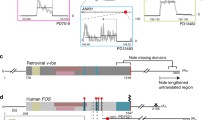Abstract
We examined structure and expression of the p53 and Rb genes in a C3HOS transplantable mouse model of osteosarcoma. The results were compared to analogous studies conducted with five human osteosarcoma cell lines. The p53 gene was found rearranged in the mouse tumour. The rearrangement mapped to the first intron region of the p53 gene and as a result, no p53 expression could be detected in C3HOS tumours. Using p53 genomic probes, we have detected the same rearrangement in the original radiation-induced tumour and the various clones that were isolated from it. Deletion and rearrangement of the p53 gene were also found in three out of five of the human osteosarcoma cell lines (MG-63, G-292, Saos-2). No p53 expression could be detected in these three cell lines. In the affected human osteosarcoma cell lines, the rearrangement involved the first intron region. In addition, the mouse tumor was analysed for structural and expression changes in the Rb and the c-myc genes. Normal expression of both genes were detected in the murine tumour. Only one (Saos-2) human osteosarcoma cell line exhibited gross structural alteration in the retinoblastoma gene. The results suggest that the inactivation of p53 may be an important step in the development of osteosarcomas, and that a rearrangement affecting the first intron is common in osteosarcomas.
Similar content being viewed by others
Author information
Authors and Affiliations
Rights and permissions
About this article
Cite this article
Chandar, N., Billig, B., McMaster, J. et al. Inactivation of p53 gene in human and murine osteosarcoma cells. Br J Cancer 65, 208–214 (1992). https://doi.org/10.1038/bjc.1992.43
Issue Date:
DOI: https://doi.org/10.1038/bjc.1992.43
- Springer Nature Limited
This article is cited by
-
Intracellular FGF1 protects cells from apoptosis through direct interaction with p53
Cellular and Molecular Life Sciences (2023)
-
Identification of Synergistic, Clinically Achievable, Combination Therapies for Osteosarcoma
Scientific Reports (2015)
-
Y-box binding protein-1 regulates cell proliferation and is associated with clinical outcomes of osteosarcoma
British Journal of Cancer (2013)
-
Chemotherapeutic induction of mitochondrial oxidative stress activates GSK-3α/β and Bax, leading to permeability transition pore opening and tumor cell death
Cell Death & Disease (2012)
-
Osteocalcin Gene Expression Is Regulated by Wild-Type p53
Calcified Tissue International (2011)




